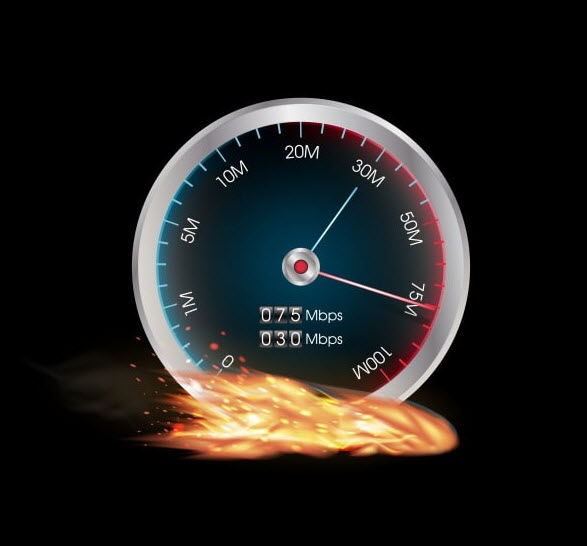Australia’s National Broadband Network (nbn) has revolutionized internet access across the country, bringing high-speed broadband to homes and businesses alike. However, navigating the world of nbn speed can be confusing, with different technologies, speed tiers, and factors affecting performance. This comprehensive guide aims to demystify nbn speed, providing you with the knowledge to make informed decisions about your internet connection.
What is nbn speed and why does it matter?

nbn speed refers to the rate at which data can be downloaded and uploaded through the nbn network. It’s typically measured in megabits per second (Mbps), with higher numbers indicating faster speeds.
nbn speed is crucial because it directly impacts your online experience. Faster speeds translate to:
- Smoother streaming: Enjoy high-definition video streaming without buffering or lag.
- Faster downloads: Download large files, such as movies and games, in a fraction of the time.
- Improved gaming: Experience seamless online gaming with reduced latency and lag.
- Efficient working from home: Support video conferencing, file sharing, and other demanding tasks with ease.
- Seamless connectivity for multiple devices: Connect numerous devices simultaneously without compromising performance.
Factors Influencing nbn speed
While your chosen speed tier plays a significant role, several other factors can influence your actual nbn speed:
-
nbn technology type: Different nbn technologies offer varying maximum speeds. Fiber to the Premises (FTTP) generally provides the fastest speeds, followed by Fiber to the Curb (FTTC), Hybrid Fiber Coaxial (HFC), Fiber to the Building (FTTB), and Fiber to the Node (FTTN). Fixed Wireless and Satellite offer slower speeds due to technological limitations.
-
Network congestion: During peak usage times, typically in the evenings, network congestion can slow down speeds.
-
Distance from the node (for FTTN connections): The further your premises are from the node, the more likely you are to experience slower speeds.
-
Internal wiring: Outdated or faulty wiring within your home can impede nbn speed.
-
Wi-Fi interference: Interference from other devices, physical obstacles, and neighboring Wi-Fi networks can affect wireless speeds.
-
Modem and router quality: Using a high-quality modem and router can optimize your nbn speed.
Understanding nbn speed Tiers
nbn offers a range of speed tiers to cater to different needs and budgets. These tiers are typically categorized as follows:
- Basic: Suitable for light internet usage, such as browsing and email.
- Standard: Adequate for small households with moderate internet usage, including streaming and social media.
- Standard Plus: A good option for households with multiple users and devices, enabling smoother streaming and faster downloads.
- Premium: Ideal for larger households with heavy internet usage, supporting multiple simultaneous activities like streaming, gaming, and video conferencing.
- Superfast: Designed for demanding users who require the fastest speeds for activities like 4K streaming and large file transfers.
- Ultrafast: Offers the highest speeds available on the nbn network, providing a future-proof solution for bandwidth-intensive applications.
How to Choose the Right nbn speed for Your Needs
Selecting the appropriate nbn speed depends on your household’s internet usage patterns. Consider the following factors:
-
Number of users and devices: The more people and devices connected to your network, the higher the speed tier you’ll likely need.
-
Online activities: If you primarily browse and use social media, a basic or standard speed might suffice. However, if you stream high-definition videos, play online games, or work from home, you’ll benefit from a faster tier.
-
Download and upload needs: If you frequently download or upload large files, a higher speed tier will significantly reduce transfer times.
-
Budget: Faster speed tiers generally come with higher costs. Balance your needs with your budget to find the most suitable option.
Tips to Optimize Your nbn speed
-
Check your nbn technology type: Understand the limitations of your connection type and choose a speed tier accordingly.
-
Use a wired connection: Connect devices directly to your modem using an Ethernet cable for optimal speeds.
-
Optimize your Wi-Fi network: Position your router centrally, minimize interference, and use a strong password. Consider a mesh Wi-Fi system for larger homes.
-
Upgrade your modem and router: Ensure your equipment is up-to-date and capable of handling your chosen speed tier.
-
Monitor your speed: Regularly test your nbn speed using online tools like Ookla’s Speedtest to identify potential issues.
-
Contact your internet provider: If you consistently experience slow speeds, contact your internet provider to troubleshoot any problems.
The Future of nbn speed
nbn continues to invest in network upgrades and technology advancements to improve speeds and enhance the broadband experience for Australians. The rollout of FTTP is expanding, bringing ultrafast speeds to more homes and businesses.
Furthermore, nbn is exploring new technologies like 5G and fixed wireless to deliver faster speeds and greater capacity in the future. These advancements promise to further enhance the nbn speed landscape, enabling even more demanding online activities and applications.
Conclusion
nbn speed is a critical factor in determining your online experience. By understanding the different speed tiers, factors influencing performance, and optimization techniques, you can make informed decisions about your internet connection and enjoy a seamless online experience. As nbn continues to evolve and improve, Australians can look forward to even faster speeds and greater connectivity in the years to come.